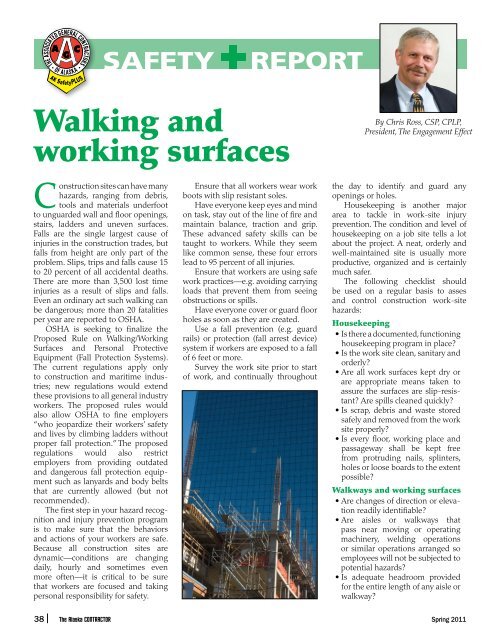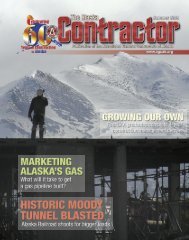The Alaska Contractor - Spring 2011 - Keep Trees
The Alaska Contractor - Spring 2011 - Keep Trees
The Alaska Contractor - Spring 2011 - Keep Trees
Create successful ePaper yourself
Turn your PDF publications into a flip-book with our unique Google optimized e-Paper software.
AK Safety<br />
PLUS SAFETY REPORT<br />
Walking and<br />
working surfaces<br />
Construction sites can have many<br />
hazards, ranging from debris,<br />
tools and materials underfoot<br />
to unguarded wall and fl oor openings,<br />
stairs, ladders and uneven surfaces.<br />
Falls are the single largest cause of<br />
injuries in the construction trades, but<br />
falls from height are only part of the<br />
problem. Slips, trips and falls cause 15<br />
to 20 percent of all accidental deaths.<br />
<strong>The</strong>re are more than 3,500 lost time<br />
injuries as a result of slips and falls.<br />
Even an ordinary act such walking can<br />
be dangerous; more than 20 fatalities<br />
per year are reported to OSHA.<br />
OSHA is seeking to fi nalize the<br />
Proposed Rule on Walking/Working<br />
Surfaces and Personal Protective<br />
Equipment (Fall Protection Systems).<br />
<strong>The</strong> current regulations apply only<br />
to construction and maritime industries;<br />
new regulations would extend<br />
these provisions to all general industry<br />
workers. <strong>The</strong> proposed rules would<br />
also allow OSHA to fi ne employers<br />
“who jeopardize their workers’ safety<br />
and lives by climbing ladders without<br />
proper fall protection.” <strong>The</strong> proposed<br />
regulations would also restrict<br />
employers from providing outdated<br />
and dangerous fall protection equipment<br />
such as lanyards and body belts<br />
that are currently allowed (but not<br />
recommended).<br />
<strong>The</strong> fi rst step in your hazard recognition<br />
and injury prevention program<br />
is to make sure that the behaviors<br />
and actions of your workers are safe.<br />
Because all construction sites are<br />
dynamic—conditions are changing<br />
daily, hourly and sometimes even<br />
more often—it is critical to be sure<br />
that workers are focused and taking<br />
personal responsibility for safety.<br />
Ensure that all workers wear work<br />
boots with slip resistant soles.<br />
Have everyone keep eyes and mind<br />
on task, stay out of the line of fi re and<br />
maintain balance, traction and grip.<br />
<strong>The</strong>se advanced safety skills can be<br />
taught to workers. While they seem<br />
like common sense, these four errors<br />
lead to 95 percent of all injuries.<br />
Ensure that workers are using safe<br />
work practices—e.g. avoiding carrying<br />
loads that prevent them from seeing<br />
obstructions or spills.<br />
Have everyone cover or guard fl oor<br />
holes as soon as they are created.<br />
Use a fall prevention (e.g. guard<br />
rails) or protection (fall arrest device)<br />
system if workers are exposed to a fall<br />
of 6 feet or more.<br />
Survey the work site prior to start<br />
of work, and continually throughout<br />
By Chris Ross, CSP, CPLP,<br />
President, <strong>The</strong> Engagement Effect<br />
the day to identify and guard any<br />
openings or holes.<br />
Housekeeping is another major<br />
area to tackle in work-site injury<br />
prevention. <strong>The</strong> condition and level of<br />
housekeeping on a job site tells a lot<br />
about the project. A neat, orderly and<br />
well-maintained site is usually more<br />
productive, organized and is certainly<br />
much safer.<br />
<strong>The</strong> following checklist should<br />
be used on a regular basis to asses<br />
and control construction work-site<br />
hazards:<br />
Housekeeping<br />
• Is there a documented, functioning<br />
housekeeping program in place?<br />
• Is the work site clean, sanitary and<br />
orderly?<br />
• Are all work surfaces kept dry or<br />
are appropriate means taken to<br />
assure the surfaces are slip-resistant?<br />
Are spills cleaned quickly?<br />
• Is scrap, debris and waste stored<br />
safely and removed from the work<br />
site properly?<br />
• Is every fl oor, working place and<br />
passageway shall be kept free<br />
from protruding nails, splinters,<br />
holes or loose boards to the extent<br />
possible?<br />
Walkways and working surfaces<br />
• Are changes of direction or elevation<br />
readily identifi able?<br />
• Are aisles or walkways that<br />
pass near moving or operating<br />
machinery, welding operations<br />
or similar operations arranged so<br />
employees will not be subjected to<br />
potential hazards?<br />
• Is adequate headroom provided<br />
for the entire length of any aisle or<br />
walkway?<br />
38 <strong>The</strong> <strong>Alaska</strong> conTrAcTor <strong>Spring</strong> <strong>2011</strong>

















